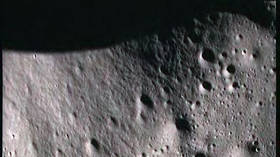Earth’s links with Moon more complex than thought, Indian probe’s data shows

Just days after India’s Chandrayaan-3 lunar mission completed its mission and went into hibernation mode, having landed on the Moon's south pole, a new study on Earth has discovered that our planet could have helped its satellite get its water.
The research, just published by the University of Hawaii at Manoa (UH Manoa), is based on data from India’s first Moon mission in October 2008. A team of scientists analyzing remote-sensor data from the Chandrayaan-1 lunar mission has found that hydrogen and oxygen ions from Earth’s plasma sheet could have combined to form water molecules on the Moon’s surface.
Shuai Li, an assistant researcher at UH Manoa School of Ocean and Earth Science and Technology, made the findings while analyzing data collected by India’s Moon Mineralogy Mapper instrument aboard India’s Chandrayaan-1 mission between 2008 and 2009.
In a statement, the university noted that Li was interested in “investigating the changes in surface weathering” as the Moon passes through Earth’s magnetotail, an area that shields the Moon from solar wind but not the Sun’s photons.
Li, as quoted by UH Manoa, explained, “This provides a natural laboratory for studying the formation processes of lunar surface water. When the Moon is outside of the magnetotail, the lunar surface is bombarded with solar wind. Inside the magnetotail, there are almost no solar wind protons and water formation was expected to drop to nearly zero.”
Li also emphasized that this discovery, along with his previous findings of rust on the lunar poles, underscores the profound connection between Earth and its moon in numerous unrecognized aspects. Scientists believe that this newfound insight could potentially elucidate the origin of previously detected water ice in the permanently shaded regions of the Moon.
“Altogether, this finding and my previous findings of rusty lunar poles indicate that mother Earth is strongly tied with its Moon in many unrecognized aspects,” Li added.
Chandrayaan-1 played a crucial role in the discovery of water molecules on the Moon. The mission was launched in October 2008 and a Moon Impact Probe struck the South Pole of the Moon on November 14. Locating water on the Moon was a fundamental scientific goal during the Indian Space Research Organisation’s preparations for Chandrayaan-1. International space agencies shared a strong interest in verifying the existence of water, ideally in substantial quantities, given its potential implications for prospective lunar habitations and insights into the Moon’s origins. NASA successfully proposed and secured the opportunity to deploy two of its water-detection instruments aboard Chandrayaan-1.
India’s subsequent lunar exploration mission, Chandrayaan-2, launched in 2019 aiming for a soft landing on the Moon but failed, and Chandrayaan-3 has emerged as a resounding success for the country. The spacecraft entered lunar orbit in early August and the lander touched down on the Moon on August 23, making India the first nation to soft-land on its south pole.













